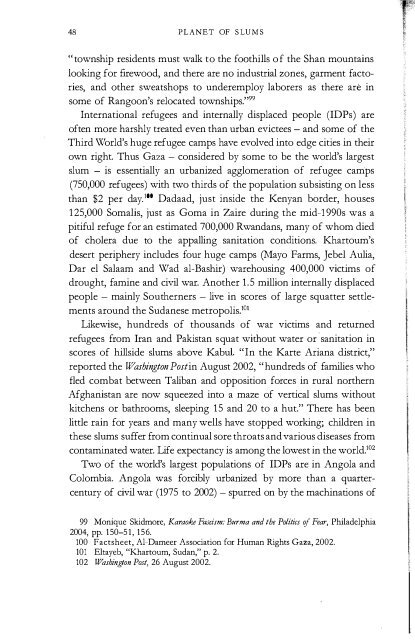Untitled - Rebel Studies Library
Untitled - Rebel Studies Library
Untitled - Rebel Studies Library
You also want an ePaper? Increase the reach of your titles
YUMPU automatically turns print PDFs into web optimized ePapers that Google loves.
48 PLANET OF SLUMS<br />
"township residents must walk to the foothills of the Shan mountains<br />
looking for firewood, and there are no industrial zones, garment factories,<br />
and other sweatshops to underemploy laborers as there are in<br />
some of Rangoon's relocated townships."99<br />
International refugees and internally displaced people (IDPs) are<br />
often more harshly treated even than urban evictees - and some of the<br />
Third World's huge refugee camps have evolved into edge cities in their<br />
own right. Thus Gaza - considered by some to be the world's largest<br />
slum - is essentially an urbanized agglomeration of refugee camps<br />
(750,000 refugees) with two thirds of the population subsisting on less<br />
than $2 per day. lOt Dadaad, just inside the Kenyan border, houses<br />
125,000 Somalis, just as Goma in Zaire during the mid-1990s was a<br />
pitiful refuge for an estimated 700,000 Rwandans, many of whom died<br />
of cholera due to the appalling sanitation conditions. Khartoum's<br />
desert periphery includes four huge camps (M:ayo Farms, Jebel Aulia,<br />
Dar el Salaam and Wad al-Bashir) warehousing 400,000 victims of<br />
drought, famine and civil war. Another 1.5 million internally displaced<br />
people - mainly Southerners - live in scores of large squatter settlements<br />
around the Sudanese metropolis.!01<br />
Likewise, hundreds of thousands of war victims and returned<br />
refugees from Iran and Pakistan squat without water or sanitation in<br />
scores of hillside slums above KabuL "In the Karte Ariana district,"<br />
reported the Washington Postin August 2002, "hundreds of families who<br />
fled combat between Taliban and opposition forces in rural northern<br />
Afghanistan are now squeezed into a maze of vertical slums without<br />
kitchens or bathrooms, sleeping 15 and 20 to a hut." There has been<br />
little rain for years and many wells have stopped working; children in<br />
these slums suffer from continual sore throats and various diseases from<br />
contaminated water. Life expectancy is among the lowest in the world.102<br />
Two of the world's largest populations of IDPs are in Angola and<br />
Colombia. Angola was forcibly urbanized by more than a quartercentury<br />
of civil war (1975 to 2002) - spurred on by the machinations of<br />
99 Monique Skidmore, Karaoke Fasdsm: Burma and the Politics f Fear, Philadelphia<br />
2004, pp. 150-51, 156.<br />
100 Factsheet, Al-Dameer Association for Human Rights Gaza, 2002.<br />
101 Eltayeb, "Khartoum, Sudan," p. 2.<br />
102 Washington Post, 26 August 2002.<br />
THE PREVALENCE OF SLUMS 49<br />
Pretoria and the White House - which displaced 30 percent of the population.<br />
Many refugees never returned to their former homes in the<br />
ruined and dangerous countryside, but squatted instead in the bleak<br />
musseques (shantytowns) that su 'ound Luanda, Lobito, Cabinda, and<br />
other cities. As a result, Angola, only 14 percent urban in 1970, is now<br />
a majority urban nation. Most of its city-dwellers are both desperately<br />
poor and almost totally ignored by the state, which in 1998 was estimated<br />
to spend only 1 percent of its budget on public education and welfare.I03<br />
The unending civil wars in Colombia likewise have added more than<br />
400,000 IDPs to Bogota's urban poverty belt, which includes the huge<br />
informal settlements of Sumapaz, Ciudad Bolivar, Usme, and Soacha.<br />
"Most displaced," explains an aid NGO, "are social outcasts, excluded<br />
from formal life and employment. Currently, 653,800 Bogotanos<br />
(2002) have no employment in le city and, even more shocking, half<br />
of them are under the age of 29." Without urban skills and frequently<br />
without access to schools, these young peasants and their children are<br />
ideal recruits for street gangs and paramilitaries. Local businessmen<br />
vandalized by urchins, in turn, form grupos de limpieza with links to<br />
rightwing death squads, and e bodies of murdered children are<br />
dumped at the edge of town.I04<br />
The same nightmare prevails on the outskirts of Cali, where anthropologist<br />
Michael Taussig invokes Dante's ltiferno to describe the struggle<br />
for survi o" stupendously dangerous" peripheral slums. Navarro<br />
is a notorious "garbage mountain" where hungry women and children<br />
pick through waste while youthful gunmen (malo de malo) are either hired<br />
or exterminated by local rightwi g paramilitaries. The other setdement,<br />
Carlos Alfredo Diaz, is full of "kids running around with homemade<br />
shotguns and grenades." "It dawns on me," writes Taussig, "that just as<br />
the guerilla have their most important base in the endless forests of the<br />
Caqueta, at the end of nowhere on the edge of the Amazon basin, so the<br />
gang world of youth gone wild has its sacred grove, too, right here on the<br />
urban edge, where the slums hit the cane fields at Carlos Alfredo Diaz. ,, 105<br />
103 Tony Hodges, Angola, 2nd ed., Oxford 2004, p. 22.<br />
104 Project Counseling Services, "Deteriorating Bogota: Displacement and War in<br />
Urban Centres", Colombia Regional Report: Bogota (December 2002), pp. 3-4.<br />
lQ$ Michael Taussig, Law in a Lawless Land: Diary f a Limpreza in Colombia, New<br />
"fork 2003, pp. 114-15.


